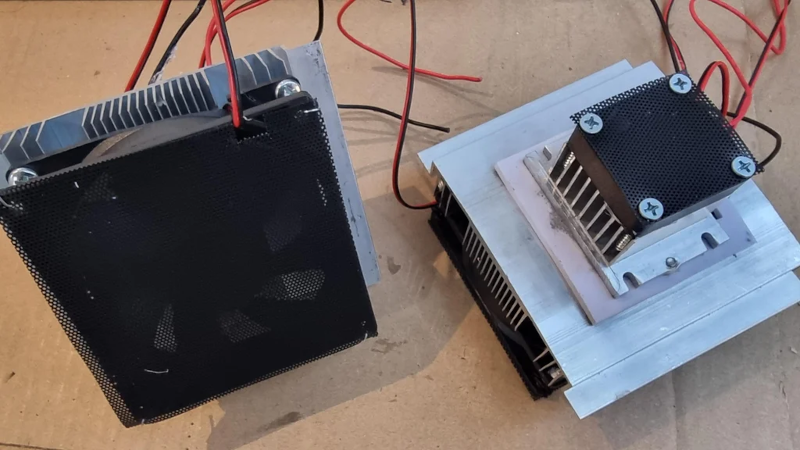How do you keep a few sodas in your classroom cool? Well, if you are teacher [Ethan Hunt], you have your students design and build a solid-state mini refrigerator that can beat his prototype fridge. The prototype uses a Peltier effect module to get three cans down to 11 C (52 F), with a final goal of reaching 5 C (41 F). It’s not all fun and games either — [Ethan] provides a suggested lesson plan with a total of thirteen modules made to fit in an hour each.
Peltier effect modules, also known as solid-state heat pumps, used to be exotic tech but are now quite common. They are actually the reverse of the Kelvin effect. Thermocouples exploit the Kelvin effect by measuring current flowing due to temperature differences.
Solid-state heat pumps use current flowing to create a comparable temperature difference. However, that’s also the catch. One side of the heat pump gets cold, but the other side gets equally hot. That heat has to go somewhere. The same is true, of course, of a “real” refrigerator or an air conditioner.
The lessons would be perfect to adapt for a class, a kid’s club, or even homeschooling. We’d love to see what your students build. You probably won’t be making liquid nitrogen with this setup. But we have seen more than one mini-fridge.















What an odd temp. I would shoot for 34, Just a bit above freezing, I like my soda cold!
Your soda might be at 34 even if do nothing
41F is the temperature to shoot for for food safety, though for canned beverages, proper holding temperature isn’t really a concern.
One of my projects during an internship at Microchip was to create a controller board to make a cheap peltier minifridge temperature-controlled. Was the first PCB I ever designed and it turned out quite well! I think it was a nice task for a first complete design, contained quite a few useful techniques, from multiplexing 7-segment displays to using an h-bridge to drive the peltier module (complete with current feedback for short detection).
Here’s an even more worthwhile challenge:
Improve the efficiency of solid state heat pumps (more commonly measured as Coefficienct of Performance, or COP) at any given delta T.
See https://www.meerstetter.ch/customer-center/compendium/71-peltier-element-efficiency
What’s the best COP/delta T for today’s solid state heat pumps, what’s the inherent limit?
Then we can work on reducing cost. I’d like to install a solid state heat pump for my home that costs no more than a conventional resdiential heat pump.
I think a solid state (Peltier) heat pump will never match the COP of a compressor pump. Otherwise, we would already have Peltier refrigerators and freezers all over.
Peltiers have their place in special purposes (chip cooling, thermoelectric generators, space electronics etc).
We do. They just suck.
The problem with the Peltier/Seebeck device is that materials which are good at conducting electricity are also very good at conducting heat, so you get massive heat leakage across the device and almost all your energy is used up fighting that, like trying to shovel dry sand with a sieve.
There’s some structural things you can do about that, to make the heat conductivity disproportionately worse than the electrical. But yes, nothing good at the moment, unless you are looking at low power density, low temperature difference, and/or heating rather than cooling.
Long ago, I got my hands on a CPU-cooling Peltier and experimented with trying to cool a can of Pepsi with it using a computer power supply.
Experiment 1: connected Peltier backwards/boiled the Pepsi to the point it ruptured the can, causing a big mess.
Experiment 2: reversed the connection/froze the Pepsi to the point it ruptured the can, which then melted and caused a big mess.
Can’t say I ever wanted to trust one of those things for their intended purposes.
Now try the same experiments with RC Cola, and report back to us the results.
B^)
OK, real cool, now try the opposite. Place the Peltier’s hot side on a wood stove side, and the cool side on a water block heat absorber. Pump the wood stove heat around the house to radiators. And get power out of the Peltier junction. Electricity in heat difference out. Heat difference in electricity out.
They make fans that run off the heat from a woodstove.
I’d have said “Seebeck” effect rather than Kelvin. What do you mean by it? In my understanding, Peltier and Seebeck are the mirrors of each other, and Thomson is included in the general thermoelectric effect, along with joule / ohmic heating and such.